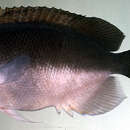mk
имиња во трошки


The halfbanded angelfish (Genicanthus semicinctus) is a species of marine ray-finned fish, a marine angelfish belonging to the family Pomacanthidae. It is found in the southwestern Pacific Ocean.
Genicanthus semicinctus like the other angelfishes in the genus Genicanthus, shows sexual dichromatism, the males and females show differences in colour and pattern. The males are marked with thin close-set wavy black, vertical bars which run from the back to two-thirds down the flanks with the lower third of the body being yellowish-orange. They have a yellow dorsal fin and yellow lobes with long filaments on the caudal fin which has black spots. The chest also has black spots. The females are plain dark grey on the back with a whitish abdomen and have dark lobes to the caudal fin. Their fins have thin blue margins and there is a black blotch above the eye, this has a vivid blue margin.[3] The dorsal fin contains 15 spines and 15-16 soft rays while the anal fin has 3 spines and 17 soft rays. This species attains a maximum total length of 21 centimetres (8.3 in).[2]
Genicanthus semicinctus is found in the southwestern Pacific Ocean. Here it is found only around Lord Howe Island, an Australian territory in the Tasman Sea, and the New Zealand outlying islands of the Kermadec Islands.[1]
Genicanthus semicinctus is found at depths between 10 and 100 metres (33 and 328 ft).[1] it is found on the deep outer slopes of coral and rocky reefs. It normally occurs in small groups, harems of a male and as many as 4 females. This species is a protogynous hermaphrodite and if the male in a group disappears the dominant female will change into a male, this change takes a few weeks.[3]
Genicanthus semicinctus was first formally described as Holocanthus semicinctus in 1900 by the British-born Australian ichthyologist Edgar Ravenswood Waite (1866–1928) with the type locality given as Lord Howe Island.[4] The specific name is a compound of semi meaning “half” and cinctus meaning “bands”.[5]
Genicanthus semicinctus is very rare in the aquarium trade.[1]
The halfbanded angelfish (Genicanthus semicinctus) is a species of marine ray-finned fish, a marine angelfish belonging to the family Pomacanthidae. It is found in the southwestern Pacific Ocean.
Genicanthus semicinctus Genicanthus generoko animalia da. Arrainen barruko Pomacanthidae familian sailkatzen da.
Genicanthus semicinctus Genicanthus generoko animalia da. Arrainen barruko Pomacanthidae familian sailkatzen da.
Genicanthus semicinctus is een straalvinnige vissensoort uit de familie van engel- of keizersvissen (Pomacanthidae).[2] De wetenschappelijke naam van de soort is voor het eerst geldig gepubliceerd in 1900 door Waite.
De soort staat op de Rode Lijst van de IUCN als niet bedreigd, beoordelingsjaar 2009. De omvang van de populatie is volgens de IUCN stabiel.[1]
Bronnen, noten en/of referentiesGenicanthus semicinctus, thường được gọi là cá thần tiên bán sọc, là một loài cá biển thuộc chi Genicanthus trong họ Cá bướm gai. Loài này được mô tả lần đầu tiên vào năm 1900.
G. semicinctus chỉ được tìm thấy tại đảo Lord Howe (Úc) và quần đảo Kermadec (New Zealand), thuộc tây nam Thái Bình Dương. Chúng thường sống xung quanh các sườn đá ngầm và các rạn san hô, thường phổ biến ở độ sâu khoảng 10 - 35 m, nhưng đã được ghi nhận ở độ sâu lên đến 100 m[1][2].
G. semicinctus trưởng thành dài khoảng 21 cm. Đây là loài dị hình giới tính rõ rệt. Cá đực có thân màu trắng xám với các sọc dọc màu đen nằm ở 2/3 thân trên, gần giống với. Phần bụng và đỉnh đầu có màu vàng cam. Vây lưng có màu cam với viền màu xanh lơ. Vây đuôi hình cánh nhạn, màu trắng, có nhiều đốm đen; hai thùy đuôi nhọn và có màu cam và viền màu xanh lơ[3].
Cá mái không có màu sặc sỡ như cá đực. Thân của cá mái có màu xám sẫm, gần như đen và có phần bụng màu trắng. Các vây đều có viền màu xanh sáng. Cá mái có một đốm đen với viền màu xanh sáng ở ngay trên mắt. Vây đuôi khá ngắn[3].
Số ngạnh ở vây lưng: 15; Số vây tia mềm ở vây lưng: 15 - 16; Số ngạnh ở vây hậu môn: 3; Số vây tia mềm ở vây hậu môn: 17[2].
G. semicinctus thường sống thành đàn nhỏ, gồm một con đực với nhiều cá mái[1][2]. Chúng hiếm khi được đánh bắt để phục vụ cho nhu cầu nuôi cá cảnh[1].
Genicanthus semicinctus, thường được gọi là cá thần tiên bán sọc, là một loài cá biển thuộc chi Genicanthus trong họ Cá bướm gai. Loài này được mô tả lần đầu tiên vào năm 1900.